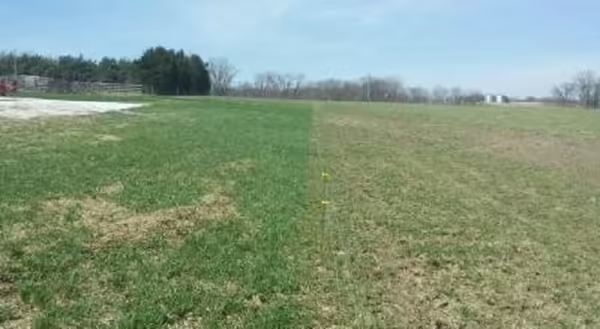
Overgrazing is the failure to match animal grazing to forage growth and production. Overgrazing occurs when animals are allowed to continuously harvest a plant without allowing the plant to feed itself. Over time, overgrazing causes reduced pasture stands and forces the cattlemen to feed purchased feeds, which are expensive and result in less profit.
Continuous overgrazing leads to many problems. First, forage yield is reduced resulting in less feed for the animal. Next, harvesting too much plant leaf handicaps the energy harvesting of the plant. Less leaf equates to less sunlight harvested. This robs energy from the roots of the plant and reduces root mass. Less root base makes the plant more susceptible to drought and will result in less ability to take up moisture and nutrients lower in the soil profile. Overgrazed forages often lead to bare areas in the pasture. As a result, soil erosion and increased weed pressure are often seen symptoms in overgrazed pastures. Finally, good soil health is very dependent on covering the soil and living roots to feed soil microbiology. Overgrazed areas poorly accomplish these basic principles of fostering good soil health.
As we approach periods of forage dormancy, it is important to review the grazing season and assess pasture management strategies. Even the best laid plan can be ruined by drought, or family emergency, or simply overstocking. However, honest appraisal of your grazing management can lead to greater opportunity to increase forage production in the coming years. The ability to identify overgrazing is a must-have skill for profitable grazers.
Questions to ask yourself when reflecting on this year’s grazing season:
- Did you overgraze in previous years due to drought?
- Did you turn out early this spring because of low hay supplies?
- Did you fail to rotate cattle during the grazing season?
- Did grass get short during the summer?
If you answer yes to any of the questions posed here, you likely had some overgrazing occur. So, when developing next year’s grazing plan, it may be beneficial to think through possible solutions. Sometimes, de-stocking is necessary. Running too many animals for too long will continue to hurt pastures. Look to utilize crop residues or cover crops to extend the grazing season and take pressure from perennial pastures. Invest in water infrastructure to allow for more even rotational grazing. Moving animals more often can increase rest days and allow for greater plant recovery. Avoid haying pastures, instead purchase stored feed and maximize grazing days. Evaluate cow weights and Animal Units (AU) for accurate stocking rates.
Now is a great time to evaluate your pastures and develop strategies to improve grazing days for next year. Feed may be less expensive this year, but it won’t stay that way. Keep making your pastures better!
*Originally published in Progressive Cattle